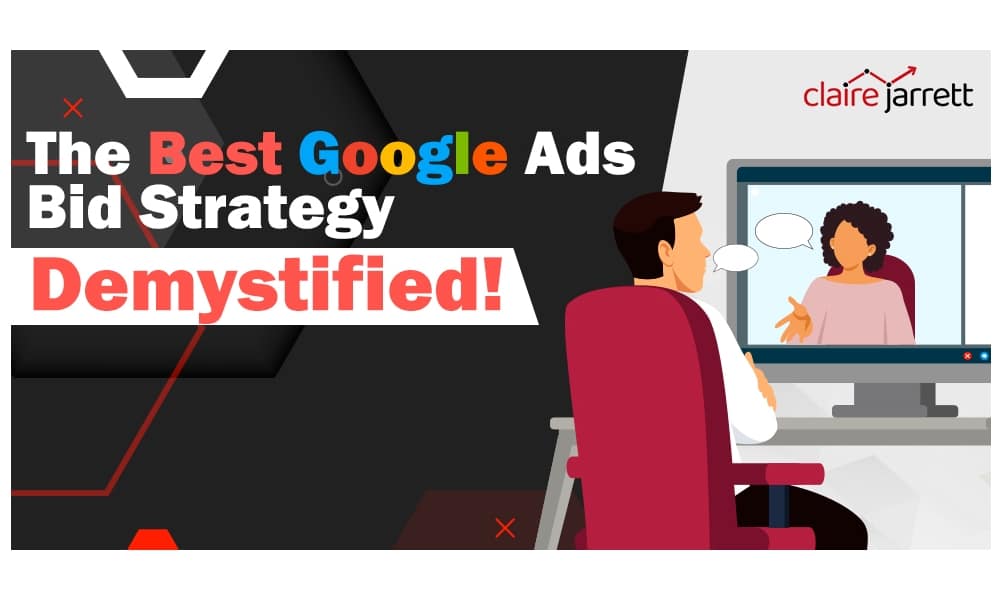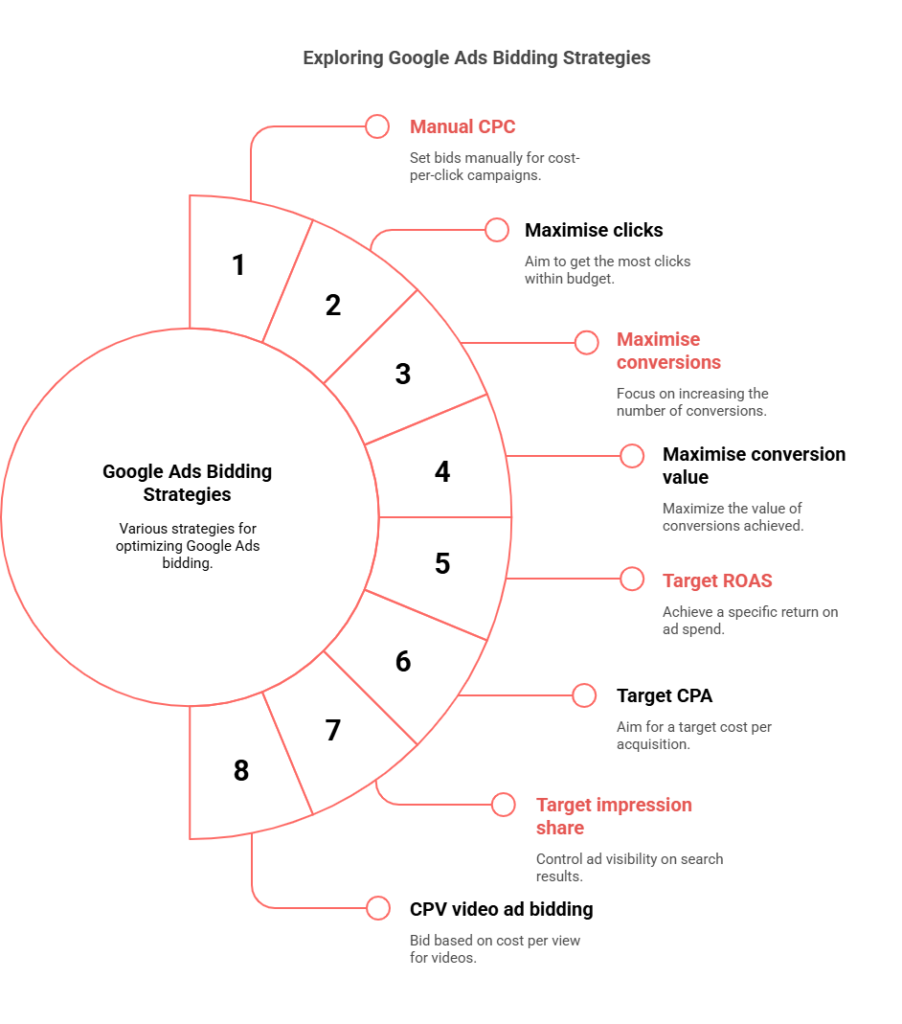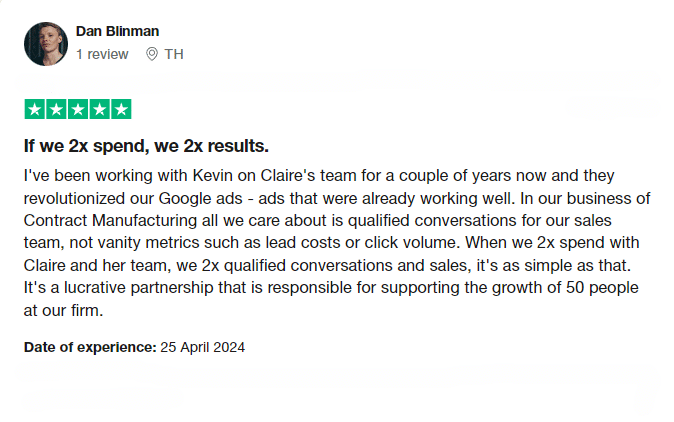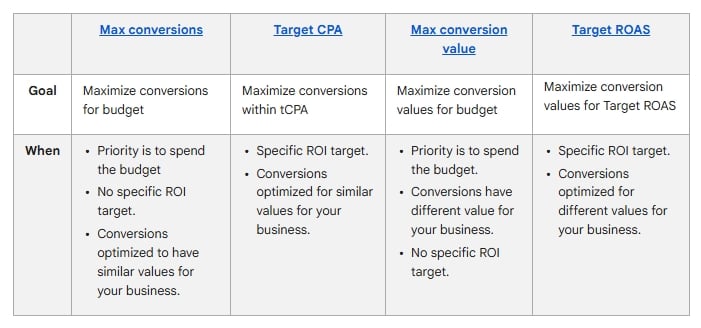The Best Google Ads Bid Strategy Demystified!

Last Updated on: 24th November 2025, 12:41 pm
Once your campaigns and ad groups are ready, it’s time to choose your Google Ads bidding strategy. And today, it’s my mission to show you everything you need to know about the best Google Ads bid strategies (and when to use them).
Let’s dive in!
Why Do Google AdWords Bid Strategies Matter?
Isn’t CPC CPC? You’d think so, but in reality – every bidding strategy is different. And it all depends on your goals. For example, just changing your bidding strategy could lead to an increase in conversions of up to a whopping 142%!
Since your bid strategy tells Google what you want to achieve, you need to crystalise your goals and select the right bidding approach.
Similarly, your bidding strategy might dictate your campaign settings. Since July 2024, Smart Bidding has been triggering the Broad Match keyword matching option. Before you choose the strategy, know what it can affect!
What Is the Best Google Ads Bid Strategy?
The best Google Ads bid strategy depends on your end goal:
- Would you like more clicks on your ads? (Because you have an automated funnel that will easily convert leads into prospects.)
- Would you like to increase your brand awareness? (Because you’re preparing to expand your market share.)
- Would you like more conversions? (Because it’s nearly Q4, and there’s no such thing as too many customers.)
- Is your budget tight?
Every factor around your campaign can – and should – affect your bid strategy. When you have an end goal in mind, you can seamlessly allocate bidding strategies to your campaigns.
Personally, I tend to gravitate towards data-driven strategies, which is why I love tCPA (Target Cost Per Action). I’ll be talking a little bit about it in just a moment!
New to Google Ads? Learn how the PPC auction works in my guide!
1. Manual CPC (Cost-per-Click) Google Ads Bid Strategy
Manual CPC lets you set the maximum amount you’re willing to pay for a click, which sounds ideal, right? And it can be, especially if you’re just starting out or your budget’s tighter than you’d like.
Manual CPC gives you full control over your bids while you’re still figuring things out.
Just know that you’re paying for the click whether or not that person sticks around, fills out your form, or ever calls your business. If your keywords are too broad or the intent’s off (among other things), you’ll spend your budget quite fast.
That’s why Manual CPC is best used for initial testing. Once you have enough data and conversions are coming in you’ll want to switch to a smart bidding strategy. Manual bidding becomes a full-time job and doesn’t scale well.
Unless you’re managing your account like it’s your day job (and if it is, hi👋), there’s a better use of your time.
Saying Goodbye to Enhanced Manual CPC
If you’ve used Enhanced CPC in the past to balance control and automation, it’s not going to be around much longer.
Google announced that Enhanced Manual CPC has been retired and all campaigns still using it will be automatically switched to Manual CPC.
No more nudging your bids up or down based on what Google thinks might convert! It’ll be either fully manual or fully automated.
If you’re not familiar: ECPC used to adjust your manual bids slightly at auction time based on signals like device, time, and browser. It didn’t use targets like tCPA or ROAS, but it gave you a little Smart Bidding edge without going all-in. I’ve recommended ECPC in the past for my PPC consultancy clients whose new campaigns where we wanted some initial conversion improvements but didn’t have enough data for full Smart Bidding. It was especially useful when they wanted Google to help a bit but not take over entirely.

2. When Should You Use the Maximise Clicks Google AdWords Bid Strategy?
Maximise clicks is automated bidding based on the maximum daily budget. Once you set your daily budget, Google will do its best to get as many clicks as possible and drive traffic to your landing page.
I use this bidding strategy in very specific cases:
- When clients are launching a brand-new campaign and need to gather initial performance data.
- When they’re testing new keywords, ad groups, or landing pages and just want an influx of traffic.
- When their landing pages already convert well, and they’re confident they can turn that traffic into leads or sales.
But it comes with a warning: Google might find cheap traffic, not necessarily the right traffic. Maximise clicks only works if you have strong landing pages and a clear path to conversion. You should also make sure your ad Quality Score is high and ready to convert.
One last thing: don’t leave it running forever. Once you have concrete data, move on to a smarter bidding strategy that focuses on results.
3. Is Maximise Conversions the Best Google Ads Bid Strategy?
Honestly? It’s quite effective!
When you use Maximise conversions, Google Ads promises to deliver as many conversions as possible within the daily budget.
Back in 2022, Google folded tCPA into Maximise Conversions as an optional setting. So instead of choosing between the two, you can now tell Google to go ahead and maximise conversions but to NOT go over, say, $50 per lead or whatever your ceiling is.
The moment you set that target, Maximise Conversions behaves like good old tCPA, optimising every auction with that limit in mind.
The amount of conversions you get depends on the type of business you run. For a B2C company, the conversion rate could be 20%, and for a B2B company running Google Ads, it could be 2%.
If you don’t set a target, though, Google will happily chase as many conversions as it can, regardless of cost. So be careful. It’s also worth testing if you have a good conversion rate and enough data, but it’ll work best in the hands of a Google Ads expert.

4. The Maximise Conversion Value Google Ads Bid Strategy
If Maximise Conversions helps you get more leads, Maximise Conversion Value helps you get better ones. And that’s why I’ve always loved this bidding strategy – it’s brilliant for improving lead quality and increasing average order values (AOV).
It works similarly to Maximise Conversions: you hand Google a budget, and it sets bids dynamically at auction time to increase your conversion value.
For example, if you’re running a campaign for premium consulting services, you don’t want Google focusing on every $25 eBook download; you want it prioritising the $2,000 strategy session bookings.
5. The Best Google Ads Bid Strategy: Target ROAS
Yep, I said “the best”, and here’s what I mean by that:
Since July 2024, Google has tucked Target ROAS inside Maximise Conversion Value as an optional setting. So instead of choosing between two strategies, you can now maximise the value of your conversion but only if you’re getting at least a certain amount of return for every $1 spent.
And when you do, it behaves just like classic Target ROAS, optimising ad campaigns with fewer menu hops and toggles to worry about.
That said, here are a few things to bear in mind with Target ROAS:
- You’ll need conversion tracking set up properly, with real transaction values. If you’re just estimating or applying the same value to every lead, you’re not ready for this strategy yet.
- If you’ve only just started reporting conversion value, give your campaigns a few weeks (or three full conversion cycles) to stabilise before diving in.
- Bid adjustments won’t apply (except for -100% device exclusions). So if you’ve been tweaking bids for mobile or location, know that this strategy ignores all of it.
A few things I always tell clients:
- You’ll need at least 15-30 tracked conversions with proper values in the past month for this to work well (more is always better).
- Your ROAS target should be grounded in reality. A 500% target is possibly doable, but not 1,000%.
This only works if you’re running campaigns tied to actual revenue. For lead gen ads or soft conversions like eBook downloads, you’re better off with a different strategy.
6. Target CPA Google AdWords Bid Strategy
With target CPA, you need to understand how much you pay for each customer action. For example, you could be spending $20 for each action.
Your goal with Google Ads’ target CPA bid strategy will be to get as many conversions as possible at the rate you set. You could experiment with your standard CPA, or you could try to target a lower CPA.
For example, let’s say you’ve been running campaigns and consistently acquiring leads at around $40 each. You can say: “$40 is my ceiling, so go fetch me as many conversions as you can for that amount.”
From there, Google uses all the signals at its disposal to adjust bids in real time and hit that average target. Some leads might cost $35, others $45, but the algorithm works to keep your average conversion cost on target.
This is an excellent start strategy if you have data to optimise against and have a higher budget than your target cost. You’ll get much more out of tCPA if your target cost is $20 and your budget is $2000 than if your cost is $20 and your daily budget is $50.
As always, it needs conversion data to make smart decisions. Otherwise, Smart Bidding suddenly isn’t that smart anymore.
“Claire…I’m a bid confused. Some of these sound so similar!”
Don’t worry, Google has an exceptional breakdown of when to use each value bidding strategy and when they match which goal:

7. The Target Impression Share Google Ads Bid Strategy
Target Impression Share lets you decide where you want to appear here on the SERPs and how often. For example, you can choose:
- Top of the page (above or near the organic results)
- Absolute top (that very first ad slot)
- Anywhere on the page
It then adjusts your bids automatically to try and hit your desired impression share, say 90% of the time at the absolute top.
I also only use this one in a select few cases: for branded terms, competitive takeover strategies, or when a client really wants to dominate a specific query.
But for general use, you’re usually better off focusing on performance. This strategy can chew through budget if you’re not careful, and it won’t necessarily bring better clicks, just more visible ones.
A few quick tips for using this Google Ads bidding strategy:
- Avoid setting the max CPC cap too low as it’ll kneecap the strategy.
- Impression share metrics only apply to the Search Network (Google only, not partners).
- Bid adjustments don’t apply here, aside from -100% device exclusions. So if you’ve been fiddling with location or time-of-day tweaks, they’ll be ignored.
If brand visibility is the absolute priority, it’s a tool worth using. Just don’t expect it to magically improve conversions. For that, you still need solid creatives, amazing ad copy, good targeting, and a landing page that earns the click. When in doubt, an experienced Google Ads consultant can improve your placement organically.
8. CPV Video Ad Bidding
If you’re running YouTube ads then CPV (Cost Per View) has its place. You’ll pay when someone watches your video (not just scrolls past it) or interacts with it by clicking on your CTA, card, or banner.
As of 2025, Google’s leaning into this strategy is hard, especially with the new multi-format Video Views campaigns. You’re not only bidding for a view on one format, but potentially showing across in-stream ads, in-feed previews, even YouTube Shorts.
And if you’re using that multi-format setup, CPV switches to Target CPV (tCPV), where you set your average desired view cost, and Google does its “smart” bidding thing around that.
If you don’t go multi-format, you’ll use Max CPV, where you set the highest amount you’re willing to pay per view.
CPV can work nicely when your goal is exposure, say, you’ve got a great explainer video or a rebrand campaign and you want eyes on it. But above all, this is a play for attention, not so much leads.
That’s why I only recommend CPV bidding when:
- You’ve got something creative worth watching.
- You care more about reach and engagement than immediate sales.
- You want to test messaging or creative concepts in a low-cost way.
IMPORTANT: Google counts a “view” differently depending on the format. On in-stream ads, it’s 30 seconds (or the full ad if it’s shorter). For Shorts, it’s 10 seconds or a CTA click.
- You won’t get charged for bumper or non-skippable ads as they’re not CPV-eligible.
Higher CPV boosts your ad rank and gets you better placements. Whether you feel like it’s a budget drain depends entirely on how you use it.
Is There One Google Ads Bid Strategy to Rule Them All?
Every campaign is different. What works for your competitor may not work for you, but there are plenty of options. You can always start with Manual CPC bidding to get acquainted with the platform.
But you’ll need data once you’re ready to scale your Google Ads. With the right information, you can identify the best leads for your business and reach them at a fraction of the cost.
If you’re ready to achieve rapid Google Ads success in 7 steps, download a copy of my best-selling Google Ads book! But if you need personalised guidance to increase your ROAS, contact me. I’d love to help you turn Google into your lead generation facility!
